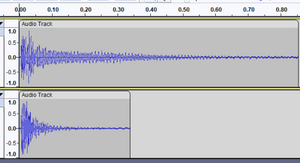Course:PHYS341/2022/Project26
Cello

History and Basic Construction
Recognizable cellos began to appear in Europe in the 1500s, representing the larger end of the violoncello family. In the 1800s, endpins began to appear to ease with bowing. Sometime between these two points the cello began to performed more frequently sitting down rather than standing up. The fingerboard or backboard and bridge were rounded over time to ease playing on one string. [1]
Outside Classical Repertoire Performance
Over the 20th century (especially from the 1950s onward), some composers (European, North&South American) began writing post-modern material. In the words of one composer, they wanted to "eliminate the tyranny of the beat." [2] So, music got a little weird. And musicians had to come up with new techniques to cope with the frontiers pushed by composers.
At least since the first decade of the 2000s (if not the 1970s or 1980s), cellos have been used more and more in popular, rock, and metal (etc) music. Among a range of roles, cellists could provide a richer bass or some other less complicated role, or they could be creating a cover of a song originally written on or for a guitar or piano. (Or pipe organ.) Some of the strategies developed for the post-modern genre can be applied to these aims, while some are unique for the material. The above mentioned rounding of the backboard and bridge is one feature that modern cellists have sought to overcome. The strings of these latter instruments are designed to be physically present in flat row that is easier to play multiple strings upon, the precise opposite of the cello.
Below are waveform graphs and frequency peaks for the traditional use of a cello along with analysis of two of these less common uses.
How a Cello Produces Sound
The cello consists of four steel or metallic strings stretched over a wooden body and held under tension. As the strings are pulled by a finger (ala plucking) or a bow (made of horsehair, aided by rosin) they vibrate. This occurs at different lengths as mitigated by pressing the string firmly to the baseboard. The strings are held away from the baseboard and the body by the bridge.
Or the string can be played 'open', with the length unmodified, as below on the 'C' string

One can see in this depiction how much varying pressure upon the bow effects the waveform - little variations in pressure/attention on the part of the cellist make a noticeable difference to the shape over the 6 seconds of the stroke or pull of the bow.
Additionally 'harmonics' can be played by lightly touching the string at particular spots. This raises the frequency by an octave

Example: Beyond the Bridge
Another example of unusual technique is utilizing the strings after they have made contact with the bridge. Here the string is very stiff, there is no room to place fingers to modify it really, and there are about only 2 inches of "playable" string between the bridge and coloured string that identifies the string-maker.[3]

Example: Body as Percussion
One example of non-traditional cello technique would be to use the body as a percussive instrument. This could take advantage of the numerous harmonic resonances built into the asymmetrical interior body of the cello. Below is an illustration of where each sound was produced along with waveforms and frequencies. Each sound was created against the upper right front body to mimic the most natural and easiest position to integrate with playing the strings.
'Tap' with the bow against the edge of the cello body. Within out a drumstick or dowel this can't be done with the left hand as the bow is primarily in the right.
This is the easiest and most natural place to tap if alternating between plucking and tapping.

'Slap' with an open palm on the centre of the area.

Some caveats though. Firstly:

it's harder for the right hand to reach this side and couldn't create as strong a sound. Seen in the simplicity of waveform and reduced length.
On the Top is with the left on the Bottom is with the right
With less force there may be less power
'Knock' with my knuckles against the cello body in one motion. Some noise from A fine tuning peg rattling.

On the Top is with the left on the Bottom is with the right
With less force there may be less power
Does it only differ in what you're already doing with your right hand
The tap does not appear to produce harmonic resonance. Which could be useful
References
- ↑ [doi:10.1017/CCOL9780521621014.002], Dilworth, John. 1999. “The Cello: Origins and Evolution.” Chapter. In The Cambridge Companion to the Cello, edited by Robin Stowell, 1–27. Cambridge Companions to Music. Cambridge: Cambridge University Press.
- ↑ [doi:10.1017/CCOL9780521621014.014], Uitti, Frances-Marie. 1999. “The Frontiers of Technique.” Chapter. In The Cambridge Companion to the Cello, edited by Robin Stowell, 211–23. Cambridge Companions to Music. Cambridge: Cambridge University Press.
- ↑ https://www.thesoundpost.com/files/en/Colors_English_new_cello.pdf